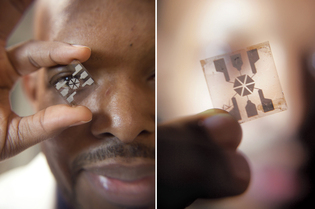 loading
loading
Inventions that will help save the world (if we let them) Mark OstowAndré Taylor’s 2,000-square-foot lab is full of materials and devices he designed and built himself, including a solar simulator for use in testing the solar cell project he is working on. Above, he holds a solar cell. View full imageFor André Taylor, assistant professor of chemical and environmental engineering, commercialization of his work on carbon nanotube technology probably remains years away. “We’re in the very basic early research phase,” he says. Taylor, who began his energy research in 2001 at the University of Michigan as a graduate student, is trying to create low-cost films that will make solar devices more efficient. One of the most widely used materials in solar cells is polysilicon; it’s relatively cheap to produce, but can convert only 20 to 25 percent of the light it captures into electricity. Single-crystalline silicon is more efficient than polysilicon, but is less often used because it’s costly to produce in the form that’s needed for solar cells. In his 2,000-square-foot lab, which is full of materials and devices he designed and built himself, Taylor is looking for a way around this problem. He and his staff have created numerous materials—out of polymers, small molecules, and nanotubes—and characterized their photovoltaic properties using a small black metal box that functions as a solar simulator. In a pair of recent papers, they described how one of these materials showed “unprecedented” potential to improve solar cells. Taylor and his lab team applied thin, smooth carbon nanotube films to a surface of single-crystalline silicon. The films provided the high levels of electrical conductivity and light absorption necessary to take advantage of the silicon’s photovoltaic properties—but without the usual expensive production process. The result was an important step toward a new form of hybrid carbon-silicon solar cell. A cheaper, more efficient solar cell sounds highly marketable. But bringing it to market won’t be a quick or simple process. Industries such as software and electronics are accustomed to adopting new methods, Taylor says, but those in the building, manufacturing, and automotive sectors “are not as quick to adapt. There’s a fair bit of resistance to new technologies like this, because manufacturers have to justify the retooling cost.” That is, if they’re going to alter their factories, they have to be reasonably certain of securing “performance advantages or future markets for the new technology. That’s a major challenge.” How does a scientist get an idea into the marketplace? “If you have a strategic plan and patient investors, maybe you can make it,” says Taylor. “But it has to show potential and add value.” New startups are springing up and succeeding all the time, he notes. But the gap between a scientific advance and actual sales of the end product is often referred to as “the Valley of Death.” Like many universities, Yale has set up an institution that exists to help inventions make it across that gap. Yale’s Office of Cooperative Research (OCR), created in 1982, is staffed by 18 experts who understand the process of commercialization. Seven of OCR’s staff, most of them PhDs in life sciences or chemistry, work exclusively on licensing faculty ideas. Each works with some 100 or more professors, from all over the university, keeping a careful eye on their work. OCR, according to John W. Puziss, director of technology licensing, “markets Yale inventions through its website and by networking, cold-calling, e-mail, and going to conferences. Almost everyone in our group comes from industry, so we follow biotech and other news very closely. We’re much more in tune with that than faculty, so we have a fairly extensive network of contacts.” The office spends millions each year to obtain patents. Each US patent can cost up to $100,000 and, according to OCR staff, securing broad international patent coverage can cost “easily” $1 million. In 2012, 31 US patents and 37 international patents were issued to Yale faculty. As at other universities, the return on investment is considerable. Federal law requires faculty to assign their inventions to Yale. In return, inventors receive a portion of any revenues Yale gains in commercializing those inventions. The first $100,000 of net royalties are split between the inventor and Yale. Sixty percent of royalties between $100,000 and $200,000 go to Yale, and 70 percent of royalties over $200,000. The university’s share, according to Puziss, goes first to reimburse OCR for patent and other expenses, and the rest is invested in Yale research. Of all the patents OCR obtains, 55 to 60 percent eventually get licensed. Puziss says it’s hard to know how many of those lead to products on the market.
|
|